 The Codex Purpureus Rossanensis is a 6th century Greek manuscript written in uncial script (upper case script with rounded letters in use from the 4th-8th centuries) that contains the gospel of Matthew, most of the gospel of Mark (verses 14-20 of chapter 16 are missing) and the Epistula ad Carpianum (a letter from Eusebius
The Codex Purpureus Rossanensis is a 6th century Greek manuscript written in uncial script (upper case script with rounded letters in use from the 4th-8th centuries) that contains the gospel of Matthew, most of the gospel of Mark (verses 14-20 of chapter 16 are missing) and the Epistula ad Carpianum (a letter from Eusebius 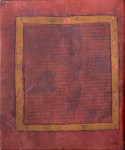 of Caesarea, the “Father of Church History,” to Carpianus on the concordance of the four gospels). Because of the letter and an illumination of all four evangelists, scholars believe the 188-page codex was originally more than double the size and included all four gospels. It’s not certain where it was written. Comparisons with other manuscripts suggest Antioch is a possibility, as is Byzantium.
of Caesarea, the “Father of Church History,” to Carpianus on the concordance of the four gospels). Because of the letter and an illumination of all four evangelists, scholars believe the 188-page codex was originally more than double the size and included all four gospels. It’s not certain where it was written. Comparisons with other manuscripts suggest Antioch is a possibility, as is Byzantium.
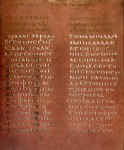 It is one of several surviving manuscripts of the New Testament known as the Purple Uncials or Purple Codices after their reddish or purple pages. The vellum was dyed the royal color and the text written in silver and gold ink. St. Jerome, author of the Vulgate, the first comprehensive translation of most of the Bible into Latin, defended himself against charges that he was rejecting the authority of the Greek writers of the Septuagint in his translation by dismissing the purple codices as pretty but inaccurate.
It is one of several surviving manuscripts of the New Testament known as the Purple Uncials or Purple Codices after their reddish or purple pages. The vellum was dyed the royal color and the text written in silver and gold ink. St. Jerome, author of the Vulgate, the first comprehensive translation of most of the Bible into Latin, defended himself against charges that he was rejecting the authority of the Greek writers of the Septuagint in his translation by dismissing the purple codices as pretty but inaccurate.
“Let whoever will to keep the old books, either written on purple skins with gold and silver, or in uncial letters, as they commonly say, loads of writing rather than books, while they leave to me and mine to have poor little leaves and not such beautiful books as correct ones.”
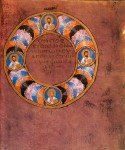 For them to have been held up as examples of old-fashioned scholarship, the purple Bibles must have been widespread in Christian theological circles when Jerome wrote that in 394 A.D.
For them to have been held up as examples of old-fashioned scholarship, the purple Bibles must have been widespread in Christian theological circles when Jerome wrote that in 394 A.D.
Most of the surviving Codices Purpurei date to the 6th century, but there are examples as early as the 4th or 5th century (Codex Vercellensis Evangeliorum,
Codex Veronensis, Codex Palatinus) and as late as the 9th century (Minuscule 565, Minuscule 1143). There are Purple Codices written in Greek and Latin, and one in Gothic (Codex Argenteus). They were created in numerous place within the Roman’s former sphere of influence, from Syria to Anglo-Saxon England to Byzantine Greece.
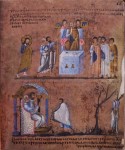 The Rossano Codex is particularly notable for its 14 illuminations depicting the life and ministry of Jesus. It’s one of the earliest surviving illuminated gospels and contains two of the first and most significant representations of Pontius Pilate. He’s depicted as a white-haired judge seated on a curule chair, a symbol of Roman political power because only magistrates were allowed to sit on them. Only one other purpureous codex from the 6th century, the Vienna Genesis, is illuminated, and it’s a fragment of the
The Rossano Codex is particularly notable for its 14 illuminations depicting the life and ministry of Jesus. It’s one of the earliest surviving illuminated gospels and contains two of the first and most significant representations of Pontius Pilate. He’s depicted as a white-haired judge seated on a curule chair, a symbol of Roman political power because only magistrates were allowed to sit on them. Only one other purpureous codex from the 6th century, the Vienna Genesis, is illuminated, and it’s a fragment of the 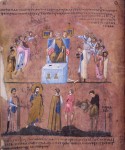 Septuagint, specifically the Book of Genesis, so no Jesus or Pilate. Images include the above-mentioned four evangelists, Lazarus being raised from the dead, the entry into Jerusalem, the parable of the ten virgins, the Last Supper (in which Jesus and Peter recline to dine) and washing of the feet, Jesus healing the blind man, the Good Samaritan, the suicide of Judas and the Pilate scenes.
Septuagint, specifically the Book of Genesis, so no Jesus or Pilate. Images include the above-mentioned four evangelists, Lazarus being raised from the dead, the entry into Jerusalem, the parable of the ten virgins, the Last Supper (in which Jesus and Peter recline to dine) and washing of the feet, Jesus healing the blind man, the Good Samaritan, the suicide of Judas and the Pilate scenes.
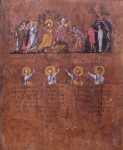 It was first brought to light by poet, literary critic and journalist Cesare Malpica in 1846, but the first to track it down to the sacristy of the cathedral of Rossano, Calabria, in southern Italy, and study it with scientific rigour were German theologians Adolf von Harnack and Oscar von Gebhardt published it internationally to great scholarly acclaim in 1879.
It was first brought to light by poet, literary critic and journalist Cesare Malpica in 1846, but the first to track it down to the sacristy of the cathedral of Rossano, Calabria, in southern Italy, and study it with scientific rigour were German theologians Adolf von Harnack and Oscar von Gebhardt published it internationally to great scholarly acclaim in 1879.
The manuscript has suffered many centuries of dismemberment, arduous travel, fire and a botched restoration in 1919 which applied hot jelly to the illuminated vellum leaves 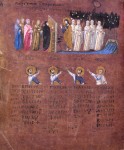 causing them to turn transparent. Alarmed by its deteriorating condition, the Rossano archdiocese enlisted the aid of Rome’s Central Institute for Restoration and Conservation of Archival and Library Heritage (ICRCPAL). From 2012 until 2015, ICRCPAL conservators worked with chemists, physicists, biologists and the latest technology to analyze and repair the Codex. There’s a nice selection of photos of the Codex and its restoration on the project website. They’re small, sadly.
causing them to turn transparent. Alarmed by its deteriorating condition, the Rossano archdiocese enlisted the aid of Rome’s Central Institute for Restoration and Conservation of Archival and Library Heritage (ICRCPAL). From 2012 until 2015, ICRCPAL conservators worked with chemists, physicists, biologists and the latest technology to analyze and repair the Codex. There’s a nice selection of photos of the Codex and its restoration on the project website. They’re small, sadly.
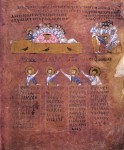 In 2015 was added to UNESCO’s Memory of the World Register of documentary heritage. Now that the restoration is complete, the Codex will return to the Diocesan Museum where it is the featured exhibit. Three newly renovated galleries are dedicated to the manuscript: one to display the Codex itself, one in which a documentary film about the work is played, one dedicated to the restoration. A new climate-controlled, continuously monitored display case will house the fragile document. The Codex Purpureus Rossanensis goes back on display on July 2nd.
In 2015 was added to UNESCO’s Memory of the World Register of documentary heritage. Now that the restoration is complete, the Codex will return to the Diocesan Museum where it is the featured exhibit. Three newly renovated galleries are dedicated to the manuscript: one to display the Codex itself, one in which a documentary film about the work is played, one dedicated to the restoration. A new climate-controlled, continuously monitored display case will house the fragile document. The Codex Purpureus Rossanensis goes back on display on July 2nd.
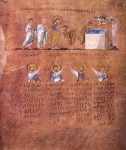
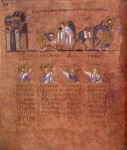
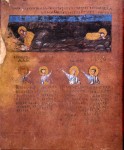
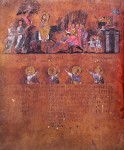
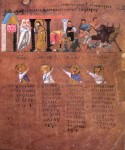
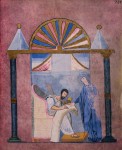
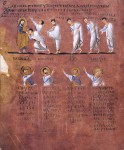
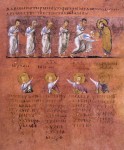
As a special Service that -hopefully- will redeem myself, I attached the Lord’s_Prayer in Gothic according to Wulfila (311–383 AD), as referred to in the ‘Codex Argenteus‘.
Here, ‘Gothic’ seems -to my ungothic eyeself- resemble Anglo-Saxon, German and last but not least -of course- English. Some of the letters resemble Greek ones, i.e. were possibly written – who knows? – by writers of Greek:
——-
𐌰𐍄𐍄𐌰 𐌿𐌽𐍃𐌰𐍂 𐌸𐌿 𐌹𐌽 𐌷𐌹𐌼𐌹𐌽𐌰𐌼 – atta unsar þu ïn himinam (Vater unser Du im Himmel, Father our, thou in heaven)
𐍅𐌴𐌹𐌷𐌽𐌰𐌹 𐌽𐌰𐌼𐍉 𐌸𐌴𐌹𐌽 – weihnai namo þein (Sei geweiht Name Dein, Be holy name thy)
𐌵𐌹𐌼𐌰𐌹 𐌸𐌹𐌿𐌳𐌹𐌽𐌰𐍃𐍃𐌿𐍃 𐌸𐌴𐌹𐌽𐍃 – qimai þiudinassus þeins (anglo-saxon þeód = nation, people ; Komme Reich Dein, Come kingdom thy
𐍅𐌰𐌹𐍂𐌸𐌰𐌹 𐍅𐌹𐌻𐌾𐌰 𐌸𐌴𐌹𐌽𐍃 – wairþai wilja þeins (Werde Wille Dein , Happen will thy)
𐍃𐍅𐌴 𐌹𐌽 𐌷𐌹𐌼𐌹𐌽𐌰 𐌾𐌰𐌷 𐌰𐌽𐌰 𐌰𐌹𐍂𐌸𐌰𐌹 – swe ïn himina jah ana airþai (Wie im Himmel als auf Erden , As in heaven also on earth)
𐌷𐌻𐌰𐌹𐍆 𐌿𐌽𐍃𐌰𐍂𐌰𐌽𐌰 𐌸𐌰𐌽𐌰 𐍃𐌹𐌽𐍄𐌴𐌹𐌽𐌰𐌽 𐌲𐌹𐍆 𐌿𐌽𐍃 𐌷𐌹𐌼𐌼𐌰 𐌳𐌰𐌲𐌰 – hlaif unsarana þana sinteinan gif uns himma daga (Laib unseren daher seiend gib uns diesen tag, Loaf ours, being everyday, give us this day, [anglo-saxon heó-dæg – heute, goth: himma daga])
𐌾𐌰𐌷 𐌰𐍆𐌻𐌴𐍄 𐌿𐌽𐍃 𐌸𐌰𐍄𐌴𐌹 𐍃𐌺𐌿𐌻𐌰𐌽𐍃 𐍃𐌹𐌾𐌰𐌹𐌼𐌰 – jah aflet uns þatei skulans sijaima [kai=greek ‘and’] (Und erlöse uns geld?schuldner seiende, And forgive us debtors being)
𐍃𐍅𐌰𐍃𐍅𐌴 𐌾𐌰𐌷 𐍅𐌴𐌹𐍃 𐌰𐍆𐌻𐌴𐍄𐌰𐌼 𐌸𐌰𐌹𐌼 𐍃𐌺𐌿𐌻𐌰𐌼 𐌿𐌽𐍃𐌰𐍂𐌰𐌹𐌼 – swaswe jah weis afletam þaim skulam unsaraim (Undalswieweis wir vergeben geld?schuldnern unseren , Just as also we forgive debtors ours)
𐌾𐌰𐌷 𐌽𐌹 𐌱𐍂𐌹𐌲𐌲𐌰𐌹𐍃 𐌿𐌽𐍃 𐌹𐌽 𐍆𐍂𐌰𐌹𐍃𐍄𐌿𐌱𐌽𐌾𐌰𐌹 – jah ni briggais uns ïn fraistubnjai (Und nicht bringe uns in Versuchung, And not bring us in temptation) [Frásiaþ, frésón to try, tempt]
𐌰𐌺 𐌻𐌰𐌿𐍃𐌴𐌹 𐌿𐌽𐍃 𐌰𐍆 𐌸𐌰𐌼𐌼𐌰 𐌿𐌱𐌹𐌻𐌹𐌽 – ak lausei uns af þamma ubilin (Aber löse uns ab Übelen, But loose us from the evilone [þamma?])
𐌿𐌽𐍄𐌴 𐌸𐌴𐌹𐌽𐌰 𐌹𐍃𐍄 𐌸𐌹𐌿𐌳𐌰𐌽𐌲𐌰𐍂𐌳𐌹 𐌾𐌰𐌷 𐌼𐌰𐌷𐍄𐍃 – unte þeina ïst þiudangardi jah mahts (Und Dein ist Königreich und Macht, And thine is kingdom and might)
𐌾𐌰𐌷 𐍅𐌿𐌻𐌸𐌿𐍃 𐌹𐌽 𐌰𐌹𐍅𐌹𐌽𐍃 – jah wulþus ïn aiwins (Und Herrlichkeit in Ewig, And glory in eternity) [angl-saxon: Wuldor= Glory, germ: Huld=gratia vs. gloria, in the original Latin and Greek version(s) ‘gratia’ and ‘gloria’ do seemingly miss completely, cf. ‘Embolism’ in liturgy, Wealth=Herrlichkeit=Lordship]
——-
– AMEN –
“the gospel of Mark (verses 14-20 of chapter 16 are missing)”: verses 9 onwards of Mark 16 are not original; they were added later by a different writer. Or so at least the scholars tell me.
Those pictures are really nice, and quite detailed. But there’s something going on with the canopy over Pilate’s chair, lol.
Yes…..all the really early Mss. have verses 9 to 20 missing.
The women saw the stone rolled from the tomb and a figure in white told them that Jesus was no longer there “You are looking for Jesus the Nazarene, who was crucified. He has risen! He is not here. See the place where they laid him. But go, tell his disciples and Peter, He is going ahead of you into Galilee. There you will see him, just as he told you.”…..the end.
Which is certainly open to ambiguity of weather Jesus actually ascended or simply left the tomb still alive.
The later verses are all relate to his resurrection and a promise of miraculous powers on to his disciples and believers.
Impartial scholars believe the verses were added to bolster the authority of the church with a stick and carrot “whoever does not believe will be condemned” if you do believe you get special powers. Ending with the unambiguous line that he was then taken up to heaven to sit at the right hand of God.
Beautiful document! I visited the museum before this restoration and am glad to hear of the renovation and the updating of the gallery.
If anyone happens to be in the neighborhood of Rossano to see the Codex, make sure you also drop by the nearby Abbazia Santa Maria del Patire, and then stop by the Amarelli licorice factory and museum – you won’t be disappointed!
Mark is easily the best crafted of the synoptic Gospels. No nativity rubbish to promote scorn and disbelief, and then a cleverly ambiguous ending. And, insofar as this amateur can tell, everything pretty much consistent with what is known about the Jewish milieu in which Jesus lived. Even a few geographical errors to let us infer that (i) Mark, whoever he really was, wasn’t entirely familiar with the lie of the land in Palestine, and (ii) the errors having been allowed to stand, suggesting that a thorough-going revision had not been imposed on it later.
I understand that the fake ending stands out a mile to anyone with a command of Biblical Greek.
The archdiocesan museum also has a lovely reproduction of the pages with illustrations for only 15 Euros. In addition to the Patirion the church of San Marco and the tiny church of the Panaghia are also worth a visit. You can ask for the keys for the latter in the archdiocesan museum and go inside.
I wish I’d known about the licorice museum!
The Amarelli licorice is the real thing – natural and very intense – made from the area’s wild licorice roots. According to the Italian Touring Club, the museum is the second most visited company museum after Ferrari.